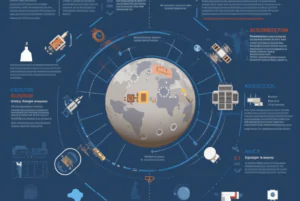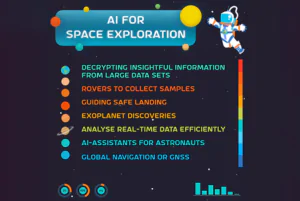Artificial Intelligence (AI) has become an integral part of modern space exploration, revolutionizing how data is processed, analyzed, and interpreted. As space missions become more ambitious and complex, the volume of data generated has grown exponentially. Traditional methods of analysis struggle to keep up, necessitating the use of AI to manage, interpret, and derive insights from this data in real-time. This blog explores the role of AI in space exploration, focusing on automated data analysis and interpretation, and discusses how it is transforming our understanding of the universe.

Overview: The Need for AI in Space Exploration
Space exploration is one of humanity’s most challenging and rewarding endeavors. The vastness of space presents not only opportunities for discovery but also immense challenges in terms of data management. Space missions generate enormous amounts of data from various sensors, cameras, and instruments. Analyzing this data manually is not only time-consuming but also prone to errors. AI, with its ability to process and analyze large datasets quickly and accurately, has emerged as a critical tool in space exploration, enabling scientists to extract valuable information from the data collected and make informed decisions in real-time.
Introduction: The Role of AI in Modern Space Missions
Space missions today are more complex than ever before. From rovers exploring the surface of Mars to telescopes capturing distant galaxies, the amount of data generated is staggering. For instance, NASA’s Mars rover, Perseverance, sends back terabytes of data including images, videos, and sensor readings. Similarly, the James Webb Space Telescope (JWST) is expected to generate up to 57 gigabytes of data every day. Analyzing this data manually would be an overwhelming task, making AI indispensable.
AI’s role in space exploration goes beyond mere data analysis. It includes tasks such as autonomous navigation, decision-making, and even predictive modeling. AI systems can learn from vast amounts of data, improving their performance over time and adapting to new challenges. This adaptability is crucial in space missions, where unexpected situations often arise, and quick, informed decisions are necessary.
The Evolution of AI in Space Exploration
The use of AI in space exploration is not entirely new. Early AI systems were used in the 1990s on the Sojourner rover, which was part of NASA’s Mars Pathfinder mission. This rover used basic AI algorithms for autonomous navigation, allowing it to move and explore the Martian surface without continuous human input. Since then, AI technology has evolved significantly, becoming more sophisticated and capable of handling much more complex tasks.
Today, AI is integrated into various aspects of space missions. It assists in everything from planning and simulation before launch to real-time operations and post-mission analysis. The advancement of AI technology has enabled the development of more autonomous spacecraft and rovers that can operate independently for extended periods, making deep space exploration more feasible.

Key Features of AI in Automated Data Analysis and Interpretation
AI-driven automated data analysis in space exploration involves several key features that enhance mission efficiency and success. These features include real-time data processing, pattern recognition, predictive modeling, and autonomous operations. Let’s explore each of these in detail.
1. Real-Time Data Processing Real-time data processing is one of the most significant contributions of AI to space exploration. Space missions often operate in environments where immediate data analysis is critical. For example, during a Mars landing, AI can process data from various sensors in real-time to ensure a safe descent and landing. This capability reduces the time lag associated with data transmission back to Earth, allowing for quicker decision-making and response.
2. Pattern Recognition Pattern recognition is another area where AI excels. Space missions involve the collection of vast amounts of data, including images, spectral data, and environmental readings. AI algorithms can analyze this data to identify patterns and anomalies that might be missed by human analysts. For instance, AI has been used to identify exoplanets in data collected by the Kepler Space Telescope by recognizing subtle patterns in the light curves of stars. These patterns indicate the presence of planets orbiting the stars, a task that would be nearly impossible to perform manually.
3. Predictive Modeling Predictive modeling is crucial for anticipating challenges and optimizing mission outcomes. AI systems can analyze historical data from previous missions to predict potential issues and suggest solutions. For example, AI can model the behavior of a spacecraft’s propulsion system under different conditions, helping engineers optimize performance and prevent failures. Predictive modeling also plays a role in understanding the potential for life on other planets by analyzing environmental data and comparing it to known conditions on Earth.
4. Autonomous Operations Autonomous operations are essential for deep space missions where communication delays make real-time human control impractical. AI enables spacecraft and rovers to operate independently, making decisions based on the data they collect. This autonomy is particularly important for missions to distant planets or moons, where delays in communication can range from minutes to hours. AI-driven autonomy allows these missions to continue without waiting for instructions from Earth, increasing their chances of success.
5. Enhanced Imaging Analysis AI’s ability to enhance imaging analysis is another critical feature in space exploration. Telescopes and spacecraft capture thousands of images that need to be analyzed to identify celestial bodies, geological features, and potential landing sites. AI algorithms can process these images quickly, enhancing their quality and highlighting important details. This capability is particularly useful for missions like the JWST, which captures images of distant galaxies and other celestial objects that are often faint and difficult to analyze.
The Impact of AI on Space Exploration
AI’s impact on space exploration is profound and far-reaching. By automating data analysis and interpretation, AI has significantly increased the efficiency and accuracy of space missions. This has led to numerous discoveries and advancements in our understanding of the universe.
1. Discovering New Worlds AI has played a crucial role in the discovery of exoplanets—planets that orbit stars outside our solar system. By analyzing data from the Kepler Space Telescope, AI algorithms have identified thousands of exoplanets, many of which are located in the habitable zones of their stars. These discoveries have opened up new possibilities for the search for extraterrestrial life and have expanded our knowledge of planetary systems.
2. Enhancing Mars Exploration Mars exploration has benefited immensely from AI technology. Rovers like Perseverance and Curiosity use AI to navigate the Martian surface, avoid obstacles, and select scientifically interesting targets for study. AI also assists in the analysis of data collected by these rovers, helping scientists identify signs of past or present life on Mars. The autonomous capabilities of these rovers have allowed them to operate effectively for years, far beyond their initial mission timelines.
3. Advancing Astrobiology AI’s ability to analyze complex datasets has advanced the field of astrobiology—the study of life in the universe. By analyzing data from rovers, landers, and orbiters, AI helps scientists assess the habitability of other planets and moons. For example, AI has been used to analyze data from the Cassini spacecraft’s flybys of Saturn’s moon Enceladus, revealing the presence of subsurface oceans that could potentially harbor life.
4. Supporting Deep Space Missions Deep space missions, such as those exploring the outer planets and beyond, rely heavily on AI for data analysis and decision-making. The vast distances involved in these missions make real-time human control impossible, so AI systems are used to operate spacecraft autonomously, analyze data, and make critical decisions. This has enabled missions like Voyager 1 and 2 to continue exploring the far reaches of our solar system long after they left Earth’s vicinity.
5. Facilitating Earth Observation AI is not only transforming our exploration of space but also how we observe and monitor Earth. Satellites equipped with AI-driven sensors are used to monitor environmental changes, track weather patterns, and respond to natural disasters. This data is crucial for understanding the impacts of climate change, managing natural resources, and protecting ecosystems. AI’s ability to process and analyze large datasets quickly allows for more accurate and timely observations, which are essential for effective environmental management.

Challenges and Ethical Considerations
While AI offers numerous benefits for space exploration, it also presents challenges and ethical considerations. The reliance on AI for critical decision-making raises questions about accountability and the potential for errors. As AI systems become more autonomous, it is important to ensure that they are thoroughly tested and validated to minimize the risks of malfunction.
Another challenge is the potential for AI to outpace human understanding. As AI systems become more complex, they may produce results that are difficult for humans to interpret. This could lead to a situation where we rely on AI without fully understanding its processes or decisions, raising concerns about transparency and trust.
Finally, there are ethical considerations related to the use of AI in space exploration. The deployment of AI-driven systems on other planets or moons raises questions about the potential impact on extraterrestrial environments. It is important to consider the ethical implications of introducing AI to new environments and ensure that space exploration is conducted in a responsible and sustainable manner.
Conclusion: The Future of AI in Space Exploration
AI is set to play an increasingly important role in the future of space exploration. As missions become more complex and data-driven, the need for advanced AI systems will only grow. The continued development of AI technology will enable more ambitious missions, including the exploration of distant planets, moons, and potentially even other star systems.
FAQs for “AI in Space Exploration: Automated Data Analysis and Interpretation”:
-
What role does AI play in space exploration? AI assists in processing and analyzing large volumes of data collected during space missions, enabling faster and more accurate interpretations, and aiding in decision-making for mission control.
-
How does AI improve data analysis in space exploration? AI algorithms can identify patterns, predict outcomes, and automate the analysis of complex datasets, which helps scientists draw meaningful insights from space observations more efficiently.
-
Can AI operate independently in space missions? Yes, AI systems can operate autonomously, making decisions in real-time based on data from sensors and instruments, which is crucial for missions that are far from Earth and have significant communication delays.
-
What are some examples of AI applications in space exploration? AI is used in rover navigation on Mars, analyzing astronomical data, detecting exoplanets, optimizing spacecraft trajectories, and managing satellite operations.
-
How does AI help in the search for extraterrestrial life? AI can analyze data from telescopes and space probes to identify potential signs of life by recognizing unusual patterns or chemical signatures that might indicate the presence of living organisms.
-
What challenges does AI face in space exploration? Challenges include the need for robust AI systems that can function in harsh space environments, the difficulty of ensuring accurate and reliable data analysis, and the complexities of autonomous decision-making in unpredictable scenarios.
-
Is AI used in the development of space missions? Yes, AI is employed in mission planning, designing spacecraft, simulating space environments, and optimizing resources to ensure successful mission outcomes.
-
How does AI handle communication delays in space missions? AI systems can make real-time decisions without waiting for instructions from Earth, which is essential for deep space missions where communication delays are significant.
-
What is the future of AI in space exploration? The future involves more advanced AI systems that can conduct entire missions autonomously, enhance our understanding of the universe, and potentially lead to new discoveries in space.
-
Can AI assist in predicting space weather? Yes, AI can analyze data from solar observations to predict space weather events, such as solar flares, which can impact spacecraft and satellites.



Vitazen Keto Gummies I really like reading through a post that can make men and women think. Also, thank you for allowing me to comment!
The degree to which I admire your work is as substantial as your own enthusiasm. Your visual presentation is refined, and the material you’ve written is stylish. However, you seem apprehensive about potentially delivering something that may be viewed as questionable. I’m confident you’ll be able to address this issue promptly.
startup talky I just like the helpful information you provide in your articles
La weekly This was beautiful Admin. Thank you for your reflections.
Real Estate I’m often to blogging and i really appreciate your content. The article has actually peaks my interest. I’m going to bookmark your web site and maintain checking for brand spanking new information.
I wanted to take a moment to commend you on the outstanding quality of your blog. Your dedication to excellence is evident in every aspect of your writing. Truly impressive!
allegheny county real estate very informative articles or reviews at this time.
allegheny county real estate Hi there to all, for the reason that I am genuinely keen of reading this website’s post to be updated on a regular basis. It carries pleasant stuff.
Fantastic site A lot of helpful info here Im sending it to some buddies ans additionally sharing in delicious And naturally thanks on your sweat
Tech to Force Very well presented. Every quote was awesome and thanks for sharing the content. Keep sharing and keep motivating others.